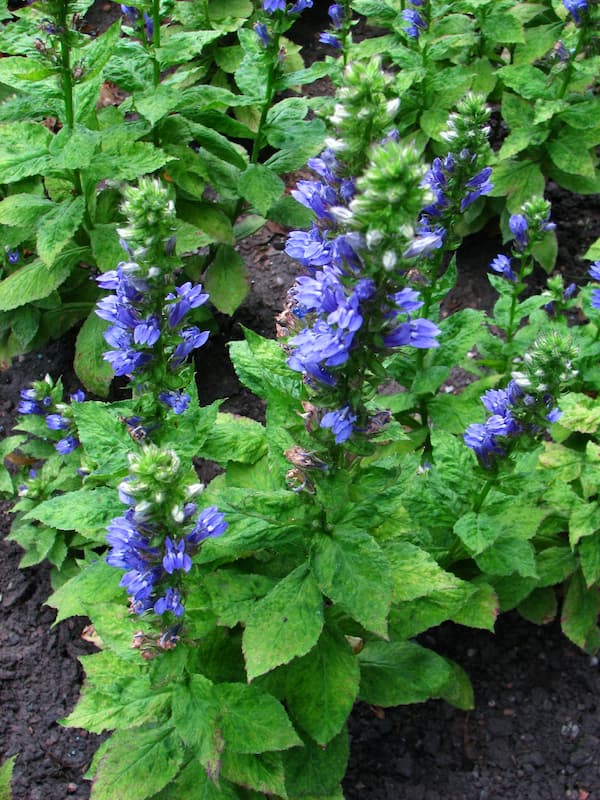Your cart is currently empty!
Great blue Lobelia
Photo:
U.S. Fish and Wildlife Service Southeast Region, Public domain
The Great Blue Lobelia is a clump-forming perennial which grows large spikes featuring bright blue tubular flowers. The showy flowers form an elongated cluster on a leafy stem. This blue counterpart of the Cardinal Flower is the most desirable plant for woodland gardens since the blue flowers offer a welcome contrast to the yellows and greens of late summer. Like the Cardinal Flower, the Great Blue Lobelia adds vertical interest to the landscape. The unfortunate species’ name, syphilitic, is based on the fact that it was a supposed cure for syphilis.
This North American native has beautiful bright blue flower spikes that rise above medium green foliage, excellent in the natural shade garden or containers; it maintains good form throughout the season and makes an excellent border planting. This species is often used as an accent, grouping or mass planting in a rain garden, wildlife garden or perennial border. Lobelia siphilitica has showy blooms and is appropriate for cottage gardens, low maintenance plantings, moist meadows, margins of water gardens, and soggy roadsides.
Quick Growing Guide

Botanical Name: Lobelia siphilitica
Also Called: Blue Cardinal Flower
En français: Lobélie bleue
Sun / Shade:
Water: Needs constant moisture
Height:
Pollinators:

Credit: Agnieszka Kwiecień, Nova, via Wikimedia Commons
The pollen and nectar of the lobelia flowers attract hummingbirds, butterflies, bumblebees, and other long-tongued bees. Lobelias produce a compound known as” lobeline,” which deters herbivores.
Seeding
Lobia seeds should be thinly sown and pressed into the seed-starting formula. The soil should be moist, and 65-75 degrees Fahrenheit is the optimal temperature. It takes about 20 days for the seedlings to emerge. You should raise the seedlings on a sunny windowsill or under fluorescent plant lights turned on 16 hours a day, off for 8 hours at night, as soon as they emerge.
Growing Great Blue Lobelia?
Great blue Lobelia typically grows to a height of 2-3 feet (60-90 cm) and spreads to a width of 12-18 inches. These clump-forming Lobelia thrive in rich, humusy soils of medium to wet moisture in partial to full sun. The soil must be very moist and fertile and should not be allowed to dry out. Fertile, well-drained soil and full sun are the best conditions for growing Lobelia. Shade from the hot afternoon sun and lots of moisture are essential to the success of blue Lobelia. You can grow the plant in water up to 3 inches during summer dry spells, but you will need to provide protection in hard winters. In addition to moist soil, partial shade, and sun, Lobelia x speciosa varieties thrive in moist conditions.
Caring for Great blue Lobelia
This is a relatively low maintenance plant, and is best cleaned up in early spring before it resumes active growth for the season.
Stratification
Blue lobelia seeds are tiny and require light to germinate, so moist stratification is unnecessary. The seeds can be sown thinly on any soil or seeding mix and given light. Also, you need moisture, so use a Ziploc bag with a tented top to hold in the moisture, but don’t let it get too wet.
Toxicity
The lower lobes of the lower lip appear larger than the upper lobes of the tubular, two-lipped flower that is light to dark blue. Bumblebees, hummingbirds, and other long-tongued bees are attracted to the nectar and pollen of the flowers.
There are a number of toxic alkaloids in Lobelia, including many that resemble nicotine structurally. Vomiting, sweating, pain, paralysis, a low body temperature, a rapid but weak pulse, collapse, comas, and even death may result from overdosing on the plant.
When does great blue lobelia flower?
When planted in medium to wet soils and in light shade, Great Blue Lobelia forms a flower spike covered in deep blue flowers from late summer to early fall. It does not grow aggressively but forms colonies when planted in medium to wet soils in light shade. Among the popular companion, summer bloomers are pansies, geraniums, and daisies that go well with Lobelia. Lobelias can be used as spillers in containers or hanging baskets or as edgers and fillers in perennial beds.
Share with Family and Friends
Featured Authors
Visit a Botanical Garden For Unique Experiences.
Comments
Logging in to comment gives you more features, but it is not required.
Subscribe
0 Comments
Oldest












